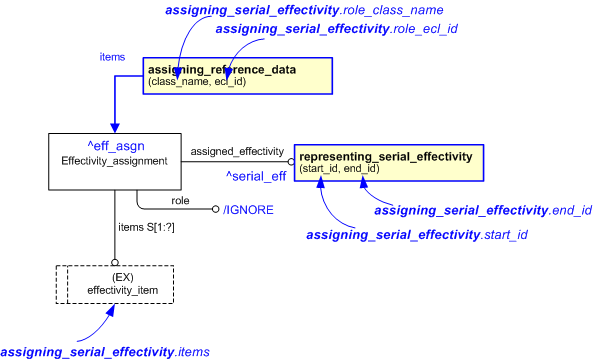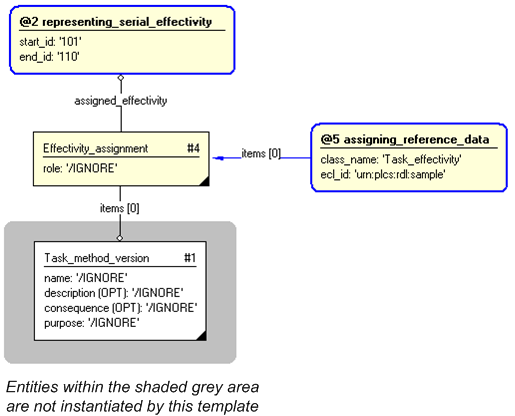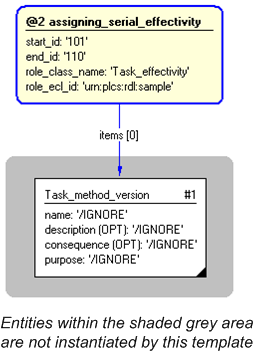Template:— assigning_serial_effectivity (asg_serial_eff)
Capability:assigning_effectivity |
Date: 2009/04/03 08:46:26
Revision: 1.3
|
This section specifies the template assigning_serial_effectivity.
NOTE
The template has been defined in the context of the capability
assigning_effectivity
which provides an overall description of the
relevant parts of the ISO 10303-239 information model and a description
of related templates.
NOTE
An explanation of a template and the associated instantiation path is
provided in the
Template overview
section.
The EXPRESS-G diagram in
Figure
1
shows the templates and EXPRESS entities that are required
to represent the template
"assigning_serial_effectivity".
The text highlighted in blue shows the template parameters.
Figure 1 — An EXPRESS-G representation of the Information model for assigning_serial_effectivity
The graphic for the template to be used in other EXPRESS-G diagrams
is shown in Figure
2
below.
Figure 2 — The graphical representation of the assigning_serial_effectivity template
The following input parameters are defined for this template:
Identification of the first serialized item within a range of serialized items.
end_id (Type='STRING', Optional)
Identification of the last serialized item within the range of serialized items.
The name of the class being used to classify the
effectivity assignment
(
Effectivity_assignment)
This provides the role for the assignment.
The following classes and their sub-classes can be used:
The identifier of the
External_class_library
storing the definition of the class referenced by the parameter @role_class_name.
The items to which the effectivity is assigned.
The following reference parameters are defined for this template:
Allow the
Serial_effectivity
entity instantiated in this path to be referenced when this template is used.
%^target = $assigning_serial_effectivity.serial_eff%
Allow the
Effectivity_assignment
entity instantiated in this path to be referenced when this template is used.
%^target = $assigning_serial_effectivity.eff_asgn%
The instantiation path shown below specifies the entities that are to be
instantiated by the template.
A description of templates and the syntax for the instantiation path is
provided in the
Templates Help/Information section.
-- Instantiate Effectivity_assignment entity Effectivity_assignment-- Set the Effectivity_assignment attribute role to be ignored Effectivity_assignment.role = '/IGNORE'
-- Bind the Effectivity_assignment to the parameter ^eff_asgn. -- The parameter is a reference parameter so the Effectivity_assignment -- entity can be referred to when this template is used. %^eff_asgn =
Effectivity_assignment%
-- Assign reference data to Effectivity_assignment /
assigning_reference_data(
items=^eff_asgn,
class_name=@role_class_name,
ecl_id=@role_ecl_id)/
-- Instantiate representing_serial_effectivity /
representing_serial_effectivity(
start_id=@start_id,
end_id=@end_id)/
Serial_effectivity-- Mark the Serial_effectivity entity as -- referable when this template is used by binding it to the reference -- parameter serial_eff %^serial_eff =
Serial_effectivity%
-- Bind the Serial_effectivity instantiated by the -- template representing_serial_effectivity -- to the parameter ^serial_eff. -- The parameter is a reference parameter so the -- Serial_effectivity can be referred to when this template is used. %^serial_eff = $representing_serial_effectivity.serial_eff%
-- Set the Effectivity_assignment.assigned_effectivity to -- the Serial_effectivity entity instantiated by -- representing_serial_effectivity Effectivity_assignment.assigned_effectivity ->
^serial_eff
-- Assign the Effectivity_assignment -- to the instances passed into the template through the @items -- input parameter (e.g. an Next_assembly_usage) Effectivity_assignment.items ->
@items
The following entities are instantiated with attributes as specified:
The instance diagram in Figure
3
shows an example of the EXPRESS entities and templates that are instantiated by the template:
/assigning_serial_effectivity(start_id='101', end_id='110', role_class_name='Task_effectivity', role_ecl_id='urn:plcs:rdl:sample', items='#1')/
(an illustration of the consolidated assigning_serial_effectivity template is shown in
Figure
4 below.)
Figure 3 — Entities instantiated by assigning_serial_effectivity template
The instance diagram in
Figure
4
shows the graphic symbol for the template that is to be
used in other instance diagrams. The example template is:
/assigning_serial_effectivity(start_id='101', end_id='110', role_class_name='Task_effectivity', role_ecl_id='urn:plcs:rdl:sample', items='#1')/
Figure 4 — Instantiation of assigning_serial_effectivity template
Characterizations
No common characterizations of the template
assigning_serial_effectivity
have been identified. However, the ISO 10303-239 EXPRESS model
may enable other assignments to the entities instantiated by the template.




